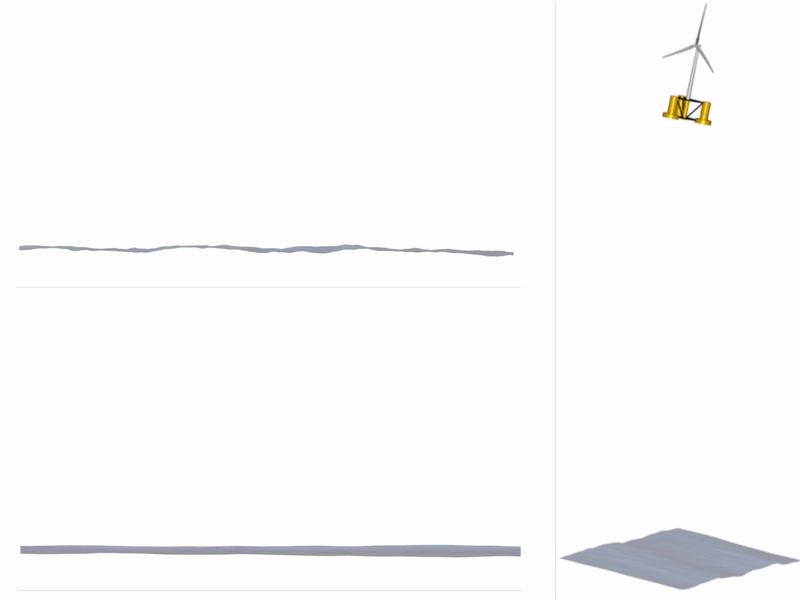Forum
Important Notice for New User Registrations
To combat an increasing number of spam and bot registrations, we now manually approve all new user registrations. While this may cause a delay until your account is approved, this step is essential to ensure the quality and security of this forum.
To help us verify your registration as legitimate, please use a clear name as user name or an official email address (such as a work, university, or similar address). If you’re concerned that we may not recognize your registration as non-spam, feel free to email us at with a request to approve your username.
Substructure & Mooring Definition for IEA 15MW VolturnUS-S
Quote from Andhi.Kusnadi on 30. June 2025, 11:14Dear all,
I am trying to understand how the simulation parameters of IEA 15MW VolturnUS-S Semi-submersible is input into QBlade in comparison to OpenFAST input of the same reference turbine. I have some doubts about how substructure properties are specified in QBlade:
- In the QBlade Sample Project input for this reference turbine (QBlade Sample Projects), I noticed that CdN for mooring line had been defined as 1.11, while the same parameters (i.e. Cd in MoorDyn) were specified as 2.0, in MoorDyn input GitHub for IEA15MW. What could be the reason for this difference, or am I not understanding the coefficients correctly?
- Could the mooring line tangential Drag & Added Mass coefficients (i.e. CdAx & CaAx in MoorDyn) be defined in QBlade?
- I notice that Buoyancy Tuner factor of 1.0093 had been defined in QBlade input. What is the background for this tuning factor?
My doubts pertaining to mooring line definition are summarised in the attached snapshot for easy reference.
Thanks & regards,
Andhi
Dear all,
I am trying to understand how the simulation parameters of IEA 15MW VolturnUS-S Semi-submersible is input into QBlade in comparison to OpenFAST input of the same reference turbine. I have some doubts about how substructure properties are specified in QBlade:
- In the QBlade Sample Project input for this reference turbine (QBlade Sample Projects), I noticed that CdN for mooring line had been defined as 1.11, while the same parameters (i.e. Cd in MoorDyn) were specified as 2.0, in MoorDyn input GitHub for IEA15MW. What could be the reason for this difference, or am I not understanding the coefficients correctly?
- Could the mooring line tangential Drag & Added Mass coefficients (i.e. CdAx & CaAx in MoorDyn) be defined in QBlade?
- I notice that Buoyancy Tuner factor of 1.0093 had been defined in QBlade input. What is the background for this tuning factor?
My doubts pertaining to mooring line definition are summarised in the attached snapshot for easy reference.
Thanks & regards,
Andhi
Uploaded files:
- You need to login to have access to uploads.
Quote from David on 30. June 2025, 14:00Hi Andhi,
please note that the official definitions of the reference turbines are constantly being updated, which may explain why the mooring-line properties of the IEA-15 MW floater differ slightly from those in the official GitHub repository.
Axial Drag Coefficient
You can assign an axial drag coefficient via aHYDROMEMBERCOEFFentry. See the Morison-equation/strip-theory modelling section of the QBlade docs for details:
https://docs.qblade.org/src/user/turbine/substructure.html#morison-equation-strip-theory-modellingAxial Added Mass
Axial added-mass coefficients are not currently supported.Buoyancy Tuning Factor
The Buoyancy Tuning Factor multiplies the buoyancy force generated by each member, and theSUB_DISPLACEDVOLUMEparameter. It linearly scales the buoyancy force and is used to fine-tune the floater’s neutral point (NP), ensuring NP sits at zero height in its equilibrium position.Best regards,
David
Hi Andhi,
please note that the official definitions of the reference turbines are constantly being updated, which may explain why the mooring-line properties of the IEA-15 MW floater differ slightly from those in the official GitHub repository.
Axial Drag Coefficient
You can assign an axial drag coefficient via a HYDROMEMBERCOEFF entry. See the Morison-equation/strip-theory modelling section of the QBlade docs for details:
https://docs.qblade.org/src/user/turbine/substructure.html#morison-equation-strip-theory-modelling
Axial Added Mass
Axial added-mass coefficients are not currently supported.
Buoyancy Tuning Factor
The Buoyancy Tuning Factor multiplies the buoyancy force generated by each member, and the SUB_DISPLACEDVOLUME parameter. It linearly scales the buoyancy force and is used to fine-tune the floater’s neutral point (NP), ensuring NP sits at zero height in its equilibrium position.
Best regards,
David


